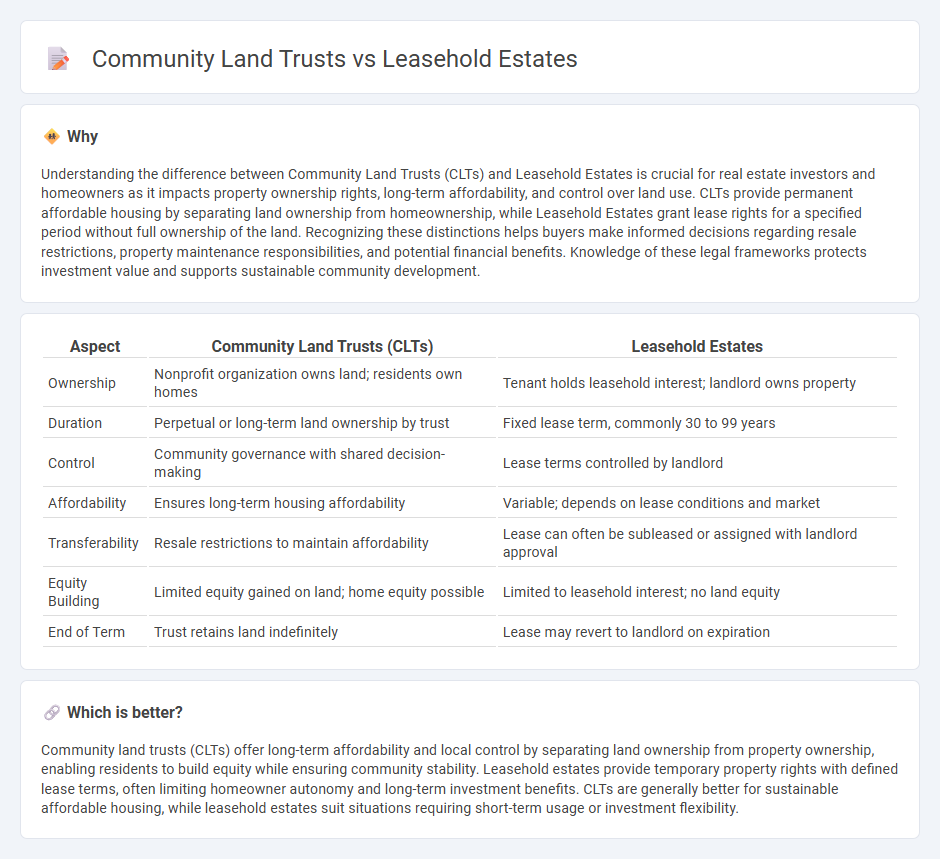
Community land trusts separate land ownership from housing ownership to ensure long-term affordability, with residents owning homes while the trust retains the land. Leasehold estates grant tenants the right to use and occupy real estate for a specified period under lease agreements, often involving renewable or transferable leases. Explore detailed comparisons between community land trusts and leasehold estates to understand which model best suits your real estate needs.
Why it is important
Understanding the difference between Community Land Trusts (CLTs) and Leasehold Estates is crucial for real estate investors and homeowners as it impacts property ownership rights, long-term affordability, and control over land use. CLTs provide permanent affordable housing by separating land ownership from homeownership, while Leasehold Estates grant lease rights for a specified period without full ownership of the land. Recognizing these distinctions helps buyers make informed decisions regarding resale restrictions, property maintenance responsibilities, and potential financial benefits. Knowledge of these legal frameworks protects investment value and supports sustainable community development.
Comparison Table
| Aspect | Community Land Trusts (CLTs) | Leasehold Estates |
|---|---|---|
| Ownership | Nonprofit organization owns land; residents own homes | Tenant holds leasehold interest; landlord owns property |
| Duration | Perpetual or long-term land ownership by trust | Fixed lease term, commonly 30 to 99 years |
| Control | Community governance with shared decision-making | Lease terms controlled by landlord |
| Affordability | Ensures long-term housing affordability | Variable; depends on lease conditions and market |
| Transferability | Resale restrictions to maintain affordability | Lease can often be subleased or assigned with landlord approval |
| Equity Building | Limited equity gained on land; home equity possible | Limited to leasehold interest; no land equity |
| End of Term | Trust retains land indefinitely | Lease may revert to landlord on expiration |
Which is better?
Community land trusts (CLTs) offer long-term affordability and local control by separating land ownership from property ownership, enabling residents to build equity while ensuring community stability. Leasehold estates provide temporary property rights with defined lease terms, often limiting homeowner autonomy and long-term investment benefits. CLTs are generally better for sustainable affordable housing, while leasehold estates suit situations requiring short-term usage or investment flexibility.
Connection
Community land trusts (CLTs) and leasehold estates are interconnected through their shared approach to separating land ownership from property ownership, which promotes affordable housing. CLTs typically acquire and hold land in trust while granting long-term leasehold estates to homeowners, allowing residents to build equity without the burden of land costs. This model stabilizes housing prices and enhances community control over land use, benefiting low- and moderate-income families.
Key Terms
Tenure
Leasehold estates grant tenants the right to use property for a specific period under a lease agreement, with ownership remaining with the landlord, emphasizing limited tenure control. Community land trusts (CLTs) provide long-term, often perpetual, land tenure by separating ownership of land and buildings, promoting affordable housing and community stewardship. Explore the distinctions between leasehold estates and community land trusts to understand their impact on property tenure and affordability.
Ground Lease
Ground leases in leasehold estates grant tenants long-term rights to use land while the ownership remains with the landlord, typically lasting 50 to 99 years, allowing significant property development without land acquisition. Community land trusts (CLTs) hold land collectively, leasing it under ground leases to residents who own the buildings but not the land, promoting affordable housing and preventing displacement. Explore the differences and benefits of ground leases in leasehold estates and CLTs to better understand sustainable property ownership models.
Equity
Leasehold estates grant individuals the right to use property for a specific period while the land remains owned by another party, often limiting long-term equity accumulation. Community land trusts (CLTs) separate land ownership from homeownership, ensuring affordability and promoting equitable access by retaining land in trust for the community's benefit. Explore how these models impact housing equity and community stability by learning more about their distinct mechanisms.
Source and External Links
Leasehold Estate | Definition, Types & Examples - This webpage provides a comprehensive overview of leasehold estates, including types and examples, highlighting the distinction between leasehold and other forms of real estate interests.
Understanding Leasehold Estate - This article explains the concept of a leasehold estate, where one party owns the property while another uses it, typically under a legally binding agreement with specific terms.
Types and Creation of Leasehold Estates - This section details the different types of leasehold estates, including estate for years, periodic tenancy, and tenancy at will, and how they are created.
 dowidth.com
dowidth.com